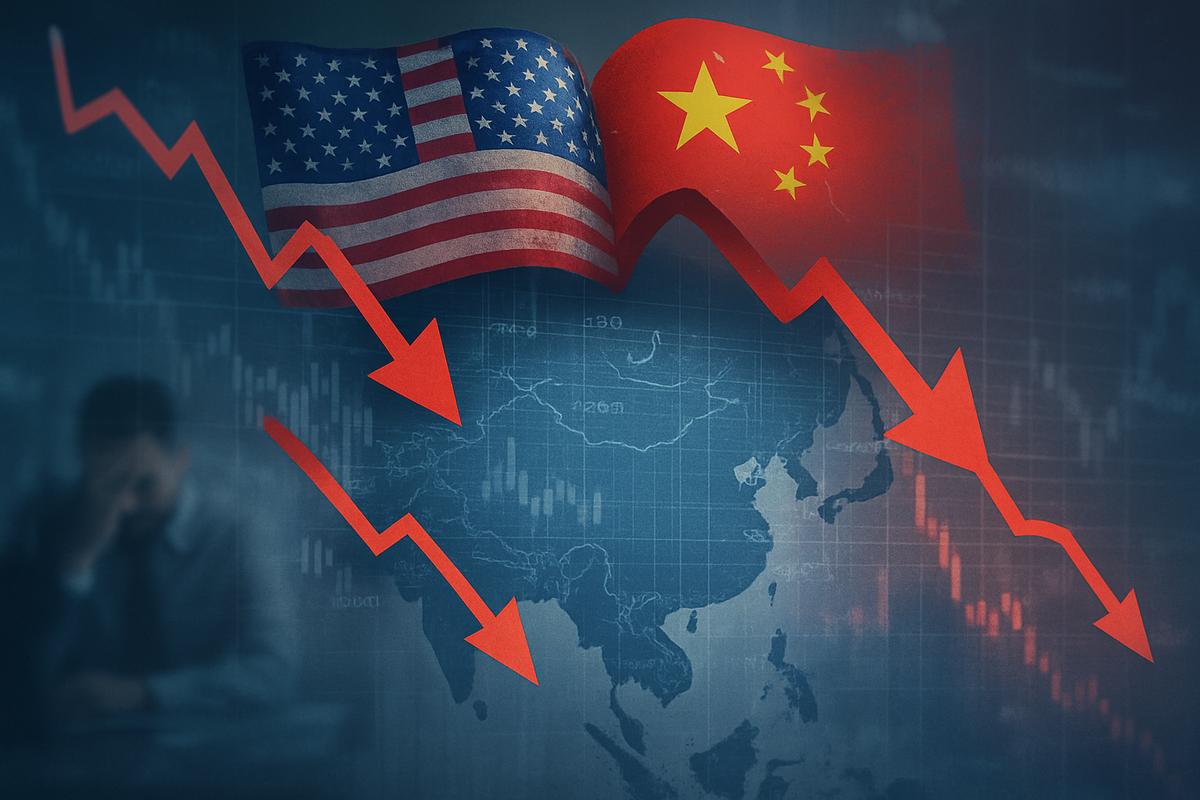
Shanghai, China – October 10, 2025 – Asian financial markets experienced a significant downturn today, with major indices plunging as escalating trade tensions between the United States and China intensified, sending ripples of uncertainty across regional economies. The renewed hostilities, marked by fresh trade restrictions from both global powers, have severely dented investor confidence, prompting a widespread flight to safe-haven assets and raising concerns about the stability of global supply chains.
The immediate fallout saw the MSCI Asia-Pacific Index slip, while Japan's benchmark Nikkei 225 (TYO: ^N225) and TOPIX indices tumbled by 1% and 1.9% respectively. Hong Kong's Hang Seng Index (HKG: ^HSI) recorded a notable 1.8% drop, extending a losing streak that reflects growing anxieties. Chinese markets were not spared, with the CSI300 Index (SHA: ^000300) falling by 1.3% and the Shanghai Composite (SHA: ^000001) slipping by 0.5%, reversing recent gains and underscoring the pervasive negative sentiment.
A Deep Dive into the Latest Trade War Front
Today's market upheaval is a direct consequence of a deepening strategic rivalry between the US and China, which has now clearly expanded beyond traditional trade disputes into a broader technological and economic competition. Both nations have recently unveiled new trade restrictions, further tightening their grip on critical industries and supply chains.
A significant development preceding today's market reaction was China's expanded export controls on rare earth production technologies, equipment, and specific rare earth elements, which became effective on October 9, 2025. This move has immediately disrupted global supply chains for magnets and electronic components, leading to price volatility in rare earth markets and accelerating international efforts to develop alternative raw material sources outside China. Furthermore, China is set to impose new export controls on high-end lithium-ion battery parts and know-how starting November 8, 2025, a measure that has already begun to impact Chinese battery manufacturers. Adding to the maritime trade friction, China also announced new special port fees on US-affiliated ships, commencing October 14, 2025. On the US side, while some export controls have been eased, new revenue-sharing mandates have been imposed on US firms operating in sensitive sectors, indicating a complex and evolving regulatory landscape.
This latest round of escalation follows earlier US tariffs imposed in April 2025, which had already put pressure on sectors like energy and basic materials. The continuous tit-for-tat actions have created an unpredictable environment, causing investors to retreat from riskier assets. The US dollar weakened against a basket of foreign currencies, with the US Dollar Index (DXY) dropping by 0.48%, as global investors reacted to the renewed trade tensions, anticipating a potentially more accommodative monetary stance from the Federal Reserve. In Japan, Finance Minister Shunichi Kato issued a verbal warning against rapid yen depreciation, which temporarily strengthened the currency, though it failed to prevent the broader equity market decline.
Companies on the Front Lines: Winners and Losers
The escalating US-China trade tensions are creating distinct winners and losers across various sectors, particularly impacting publicly traded companies with significant exposure to these geopolitical headwinds.
In the critical rare earths and critical minerals sector, China's export controls are causing severe disruptions. While Chinese rare earth companies may face internal reconfigurations, US-based rare earth stocks, such as MP Materials (NYSE: MP), have surged as investors seek domestic alternatives and supply chain resilience. This shift signals a potential boon for companies outside China capable of developing or processing these vital materials.
The electric vehicle (EV) battery and lithium industry is also heavily impacted. Chinese battery manufacturers like Contemporary Amperex Technology Co Ltd. (SHE: 300750), Tianqi Lithium (SHE: 002466), EVE Energy (SHE: 300014), and BYD (HKG: 1211) all experienced notable share declines following the announcement of new export controls on high-end lithium-ion battery parts and know-how. This could force these companies to re-evaluate their international strategies and accelerate localization efforts in other markets, while potentially benefiting non-Chinese battery producers or those with diversified supply chains.
The semiconductor and technology sector continues to be a battleground. The Chinese Semiconductor Index fell by 4.1%, and the AI sector dropped by 3.4%. The ongoing US-China semiconductor trade war has seen China accelerate its self-reliance initiatives through a substantial semiconductor fund, potentially benefiting domestic champions. Conversely, US tech giants like Nvidia (NASDAQ: NVDA), Qualcomm (NASDAQ: QCOM), and Intel (NASDAQ: INTC), heavily reliant on cross-border trade and Chinese markets, face intense selling pressure and potential revenue impacts due to export controls and revenue-sharing mandates.
In shipping and logistics, China's imposition of new special port fees on US-affiliated ships will directly affect shipping companies engaged in trans-Pacific routes. Companies like Maersk (CPH: MAERSK-B) and COSCO Shipping Holdings (HKG: 1919), with significant operations in both regions, will need to navigate increased operational costs and potential rerouting strategies. The agriculture sector, particularly in the US, continues to suffer from retaliatory tariffs, with US soybean exporters like Archer-Daniels-Midland (NYSE: ADM) and Bunge Global SA (NYSE: BG) facing drastically reduced exports to China and the need to find alternative markets. Conversely, agricultural producers in other nations that can fill the void in the Chinese market might see increased demand. Finally, gold mining companies like Barrick Gold (NYSE: GOLD) and Newmont (NYSE: NEM) are likely to benefit from increased gold prices as investors flock to safe-haven assets amidst heightened market uncertainty.
Wider Significance and Geopolitical Chessboard
The latest escalation in US-China trade tensions is not an isolated event but rather a critical juncture in a broader, evolving geopolitical and economic realignment. This event fits squarely into a trend of increasing economic nationalism and strategic decoupling, where nations prioritize supply chain resilience and technological sovereignty over unfettered globalization. The rivalry extends beyond tariffs, encompassing technology, critical minerals, and maritime influence, signaling a more entrenched and systemic competition.
The ripple effects are profound, impacting not just direct competitors but also partners and entire regional supply chains. The "China plus one" manufacturing strategy, where firms diversify supply chains outside China, is proving less reliable as other Asian nations are increasingly caught in the crossfire of US tariffs. This forces a re-evaluation of global manufacturing footprints for multinational corporations, potentially accelerating investment redirection to regions like Southeast Asia, Eastern Europe, and Africa, albeit with careful consideration of the evolving geopolitical landscape. Regulatory and policy implications are significant, with both the US and China leveraging their regulatory frameworks to achieve strategic objectives. China's expanded export controls and port fees, alongside US export controls and revenue-sharing mandates, exemplify this trend. This could lead to a fragmentation of global regulatory standards, creating complex compliance challenges for international businesses.
Historically, periods of heightened trade tensions have often led to economic slowdowns and increased market volatility. Comparisons can be drawn to previous trade disputes, though the current scenario is distinguished by its technological dimension and the sheer scale of the economies involved. The emphasis on critical minerals and advanced technologies suggests a more profound, long-term restructuring of global commerce, rather than a temporary tariff spat. The move towards de-dollarization, evidenced by increased foreign exchange hedging, also represents a significant shift from historical precedents, indicating a potential recalibration of global financial architecture.
Navigating the Uncharted Waters: What Comes Next
The path forward for Asian markets and global trade is fraught with uncertainty, demanding strategic pivots and adaptive measures from businesses and policymakers alike. In the short term, markets are likely to remain highly volatile, sensitive to every pronouncement and policy adjustment from Washington and Beijing. Investors should brace for continued capital outflows from certain Asian markets, particularly those perceived as more exposed to geopolitical risks, and further currency fluctuations as central banks grapple with the economic fallout. The immediate focus for companies will be on assessing their supply chain vulnerabilities, diversifying sourcing, and exploring regionalization strategies to mitigate risks associated with cross-border trade.
Looking further ahead, the long-term possibilities point towards a more fragmented global economy, characterized by regional trade blocs and dual supply chains. This could lead to significant strategic pivots for multinational corporations, with a renewed emphasis on localized production and market access strategies. Market opportunities may emerge for countries and companies that can offer stable, alternative manufacturing bases and innovative solutions for resilient supply chains. For instance, Southeast Asian nations, despite being impacted by broader tariffs, could potentially benefit from redirected foreign investment if they can effectively position themselves as reliable manufacturing hubs. The ongoing efforts by Southeast Asian nations to pursue regional cooperation and bilateral trade agreements are critical adaptations to build resilience against external pressures.
Potential scenarios and outcomes range from a managed de-escalation, where both sides find a way to coexist economically despite strategic differences, to a full-blown economic decoupling that reshapes global commerce for decades. A key factor will be the extent to which other major economies, particularly in Europe, align with either the US or China, or forge an independent path. The development of alternative raw material supplies outside China, especially for rare earths and critical minerals, will be a crucial determinant of future industrial landscapes. Companies that invest in R&D for material substitution and circular economy practices may find themselves at a significant advantage.
A New Era of Market Dynamics
Today's market plunge in Asia serves as a stark reminder of the profound impact that escalating US-China trade tensions are having on the global financial landscape. The key takeaway is the increasing unpredictability and systemic risk introduced by this geopolitical rivalry, which extends far beyond traditional trade tariffs into the realms of technology, critical minerals, and maritime influence. This is not merely a transient market correction but a reflection of a fundamental shift in global economic dynamics.
Moving forward, investors must adopt a cautious yet agile approach. The market will likely continue to be driven by geopolitical developments, regulatory changes, and companies' abilities to adapt their supply chains and business models. What investors should watch for in the coming months includes any signs of diplomatic breakthroughs or further escalations, the impact of new trade restrictions as they take effect (e.g., China's lithium-ion battery export controls in November), and the performance of companies that have successfully diversified their operations or are positioned to benefit from regionalization trends. The resilience of regional economies, particularly in ASEAN, and their ability to forge stronger internal trade ties will also be crucial indicators. The era of seamless globalization is giving way to a more complex, multi-polar economic order, and those who can navigate its intricacies will be best positioned for success.
This content is intended for informational purposes only and is not financial advice





